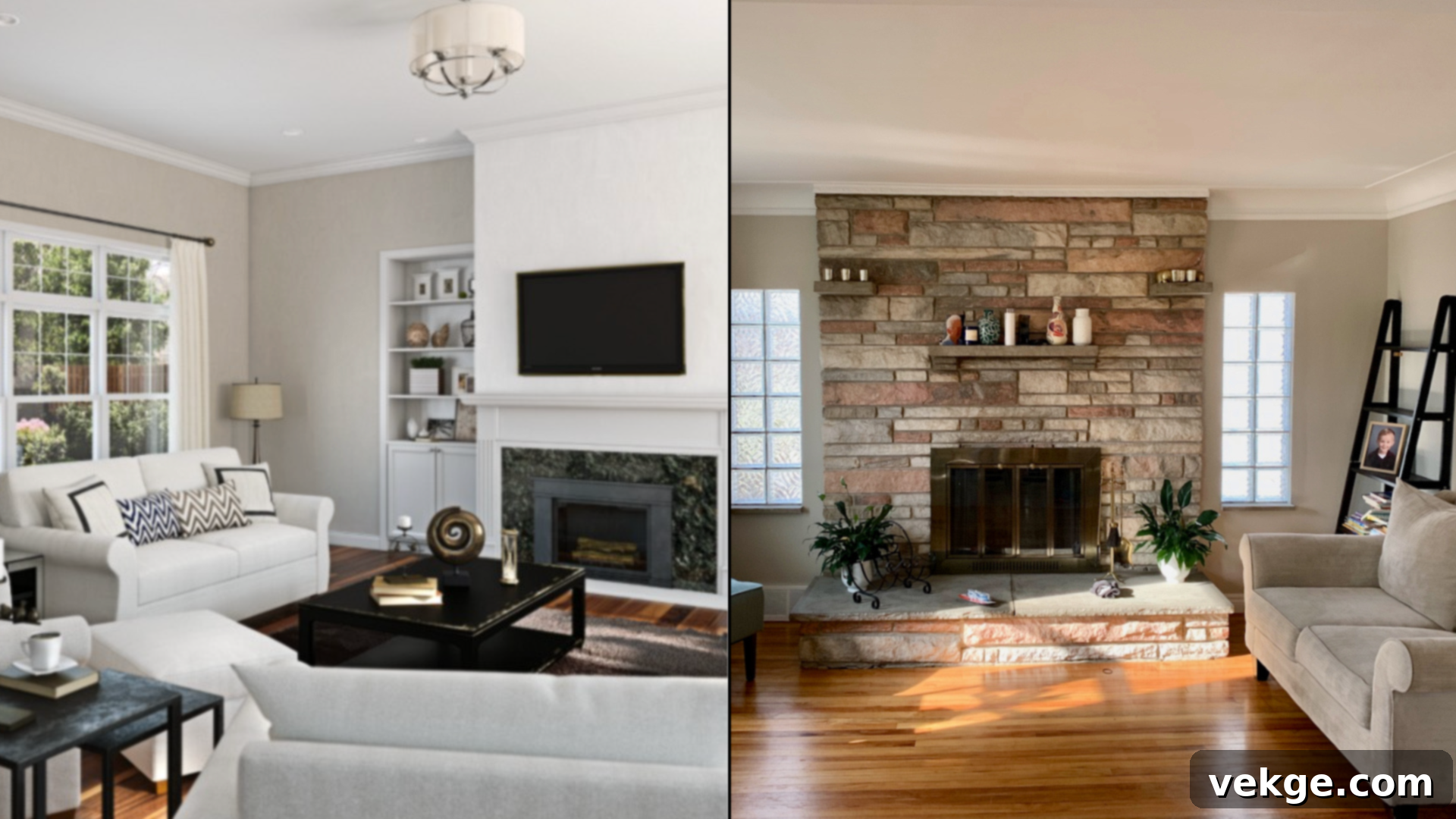Revere Pewter vs. Agreeable Gray: The Ultimate Greige Paint Color Comparison Guide
Choosing the perfect paint color for your home can feel like a daunting task, especially when two popular shades appear so similar at first glance. If you find yourself caught in the delightful dilemma between Benjamin Moore Revere Pewter and Sherwin-Williams Agreeable Gray, you’re not alone. Both are celebrated greige (gray-beige) paint colors, renowned for their versatility and ability to create a sophisticated backdrop. However, despite their shared popularity, each possesses distinct characteristics that dramatically influence how they look and feel in your specific space, depending on lighting conditions, existing finishes, and your desired aesthetic.
This comprehensive guide is designed to illuminate the subtle yet significant differences between these two iconic paint colors. We’ll delve into their unique color profiles, explore how various lighting impacts their appearance, and recommend ideal room placements and coordinating elements. By the end, you’ll have the clarity and confidence needed to select the best greige shade that truly brings your vision for your home to life.
Understanding the Nuances of Revere Pewter and Agreeable Gray
While Revere Pewter and Agreeable Gray might seem interchangeable, their underlying compositions mean they “behave” quite differently on your walls. Factors like natural light, artificial lighting, existing trim, flooring, and even the direction your room faces can reveal unexpected undertones. Let’s explore each color in detail to understand its inherent characteristics.
Revere Pewter (HC-172) by Benjamin Moore
Benjamin Moore Revere Pewter (HC-172) is a truly iconic, warm, and highly versatile greige. It masterfully balances warm beige tones with subtle, soft green-gray undertones, making it a sophisticated neutral. Part of Benjamin Moore’s esteemed Historical Color Collection, Revere Pewter has maintained its status as a homeowner and designer favorite for decades due to its depth and timeless appeal. It’s particularly well-suited for traditional and transitional spaces, where it beautifully complements natural materials like wood, stone, and various earthy textures, contributing to a grounded and inviting atmosphere.
Basic Color Profile of Revere Pewter
- HEX code:
#CBC6B8 - LRV (Light Reflectance Value): 55.98
- Color Family: Warm beige with distinct green-beige undertones
With an LRV of 55.98, Revere Pewter offers a moderate depth, reflecting a good amount of light without feeling stark. However, its green undertones are crucial to understand. In spaces with cooler northern light or low-light conditions, these green undertones can become more pronounced, giving the color a slightly mossy or muted appearance. Conversely, in warm, bright southern light, it will lean more into its beige characteristics, appearing richer and cozier. Always remember to test this shade in your specific lighting conditions to anticipate its true character.
Agreeable Gray (SW 7029) by Sherwin-Williams
Sherwin-Williams Agreeable Gray (SW 7029) is another incredibly popular greige, celebrated for its balanced and universally appealing nature. It presents as a light, warm taupe-gray that consistently reads as soft and inviting in most lighting environments. Its remarkable flexibility is a key reason for its widespread use across diverse home styles and in nearly any room, especially those with open-concept layouts or modern, clean styling.
Basic Color Profile of Agreeable Gray
- HEX code:
#D1CBC1 - LRV (Light Reflectance Value): 60
- Color Family: Warm taupe-gray with subtle beige undertones
With an LRV of 60, Agreeable Gray is slightly lighter than Revere Pewter, making rooms feel more expansive and airy while still maintaining a comforting warmth. Its primary undertones lean towards a soft beige or taupe, and it generally lacks the green undertones found in Revere Pewter. This makes Agreeable Gray a strong choice if you seek a light, sophisticated neutral that avoids feeling cold or sterile. It demonstrates excellent color consistency under both natural and artificial light, making it a safe and easy pick for painting an entire home or for rooms where light varies significantly.
Revere Pewter vs. Agreeable Gray: A Detailed Side-by-Side Comparison
To truly grasp the distinctions between these two leading greige paints, let’s place them side-by-side. Understanding these differences, even subtle ones, is crucial for making the best decision for your home.
| Feature | Revere Pewter (Benjamin Moore) | Agreeable Gray (Sherwin-Williams) |
| Color Family | Warmer, more grounded beige with an earthy base | Lighter, balanced taupe-gray with soft warmth |
| Undertones | Noticeable green and beige undertones, can shift to green in cooler light | Subtle taupe/greige undertones, minimal or no green, very stable |
| LRV (Light Reflectance Value) | 55.98 (moderate depth, absorbs a bit more light) | 60 (slightly lighter, reflects more light, feels brighter) |
| Finish Effect | Creates a solid, cozy, and substantial feel; historic appeal | Offers a clean, soft, and modern look; airy and inviting |
| Common Uses | Formal living rooms, dining rooms, studies, exteriors, traditional spaces | Open-concept living areas, kitchens, bedrooms, whole-home applications, modern/transitional styles |
| Lighting Impact | Can read darker, more muted, or pull green in cool/low light; warmer in bright, southern light | Holds its balanced tone consistently across most lighting conditions; rarely shifts dramatically |
As this comparison highlights, even a small difference in LRV and the presence or absence of specific undertones can profoundly alter how these colors present on your walls. These details empower you to predict how each shade will interact with your unique environment.
How Lighting Affects Revere Pewter and Agreeable Gray
Lighting is the single most influential factor in how paint colors appear. Both Revere Pewter and Agreeable Gray, being chameleon-like greiges, react distinctly to different light sources and intensities.
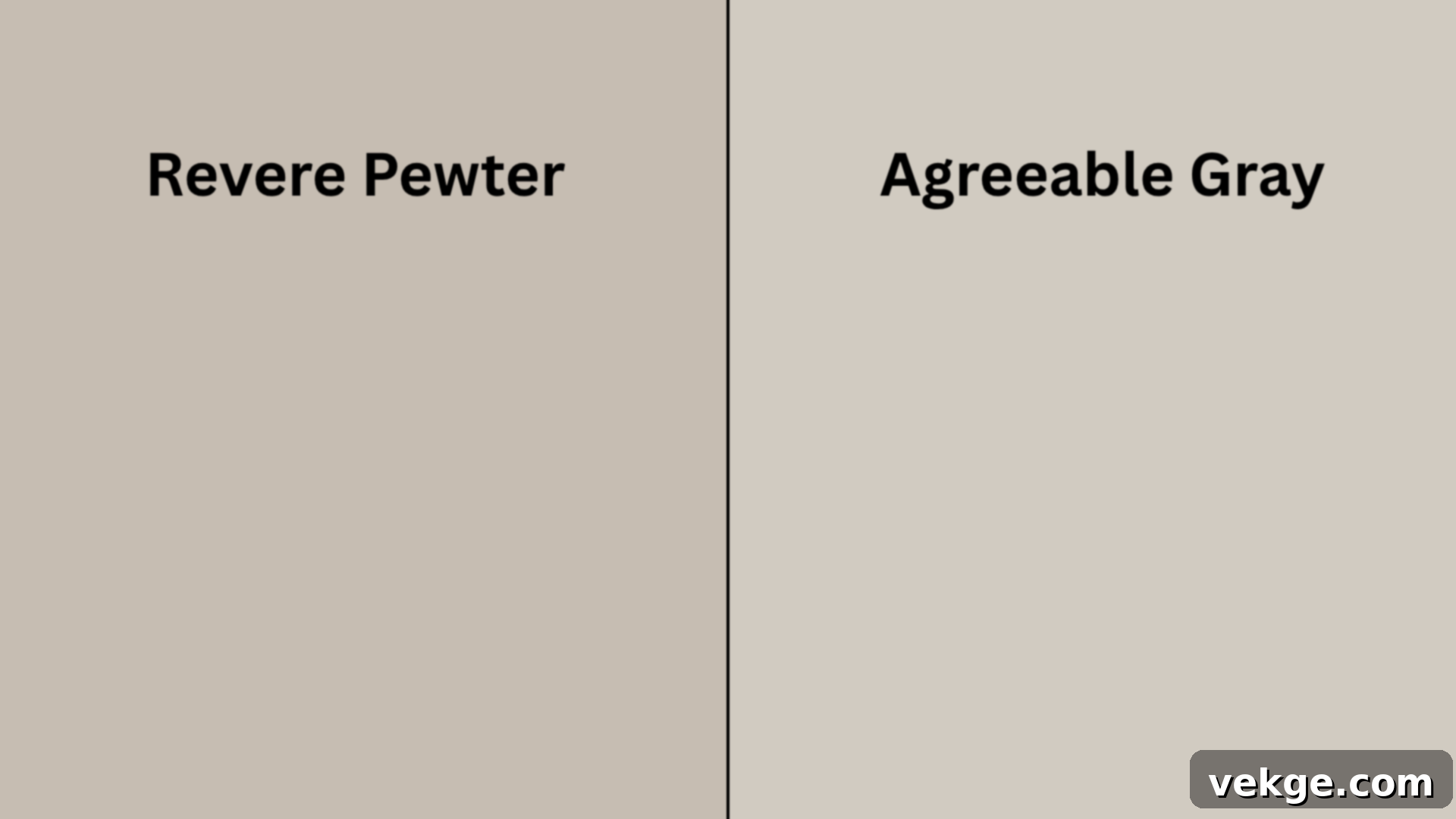
| Lighting Condition | Revere Pewter | Agreeable Gray |
|---|---|---|
| Bright Daylight (South/West Facing Rooms) | Appears warm and grounded, emphasizing its beige notes. Green undertone can be very subtle or almost disappear. | Feels bright, balanced, and exceptionally soft; maintains its perfect greige balance without getting too cool or too warm. |
| Cool Daylight (North/East Facing Rooms) | The green undertone becomes more visible, giving it a slightly muted or even a soft sage-like appearance. Can feel heavier and more traditional. | Stays reliably neutral and warm, preventing the room from feeling cold. It may appear a touch grayer but retains its welcoming quality. |
| Warm Light (Evening, Incandescent/LEDs) | Looks deeper, richer, and very cozy, with its inherent warmth becoming more prominent. The green undertone is often softened by artificial warmth. | Maintains a gentle, consistent tone; it will lean slightly warmer under artificial light but retains its overall lightness and airiness. |
| Low Light / Shade | Can become quite muted and appear heavier, more like a traditional beige-gray. Its depth is emphasized, making spaces feel more intimate. | Reflects more ambient light, creating an open and airy feel even in shaded corners. It rarely looks dull or heavy. |
This table clearly illustrates that Agreeable Gray offers greater consistency across varying light conditions, making it a more predictable choice. Revere Pewter, while beautiful, requires more careful consideration of your room’s specific light exposure due to its more active undertones.
Rooms Where Revere Pewter and Agreeable Gray Excel
The ideal application for each of these versatile greiges depends heavily on the room’s function, desired mood, and existing architectural elements.
Living Spaces (Living Room, Family Room)
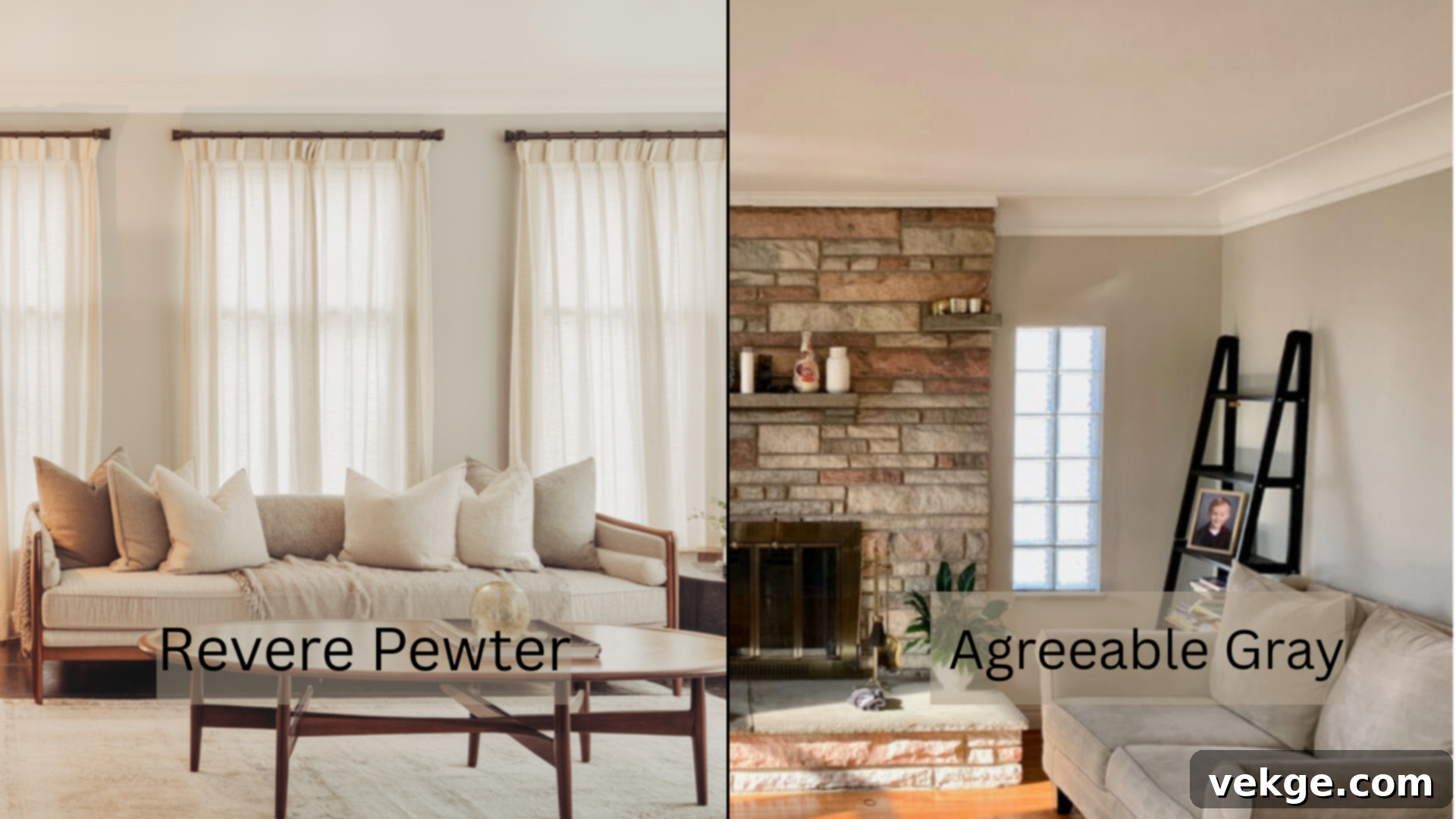
For living rooms or family rooms where you desire a warm, grounded, and slightly more formal ambiance, Revere Pewter is an exceptional choice. It adds a sense of depth and permanence, making the space feel established and inviting. It pairs beautifully with rich wood furniture, classic upholstery, and traditional artwork. In a cozy den or a formal living room, it creates a sophisticated envelope.
Conversely, Agreeable Gray lends itself to a more open, light, and contemporary feel, particularly in smaller living areas or open-concept layouts. Its higher LRV allows it to reflect light beautifully, creating an airy backdrop that effortlessly harmonizes with various furniture styles and decor without competing for attention. If your living space has mixed lighting throughout the day, Agreeable Gray’s consistent nature ensures a stable, welcoming color regardless of the hour.
Kitchen & Dining Areas

For kitchens, Agreeable Gray is a resounding favorite, especially when paired with popular choices like white, off-white, or light-colored cabinetry and countertops. It maintains a clean, bright, and modern aesthetic without feeling stark, providing a gentle warmth that works well with stainless steel appliances and contemporary finishes. Its consistent performance under various lighting, including task lighting, is a major plus.
Revere Pewter often finds its sweet spot in dining rooms, where its slightly deeper, cozier tone fosters a more intimate and sophisticated atmosphere. It harmonizes beautifully with dark wood dining tables, antique furniture, and warmer lighting fixtures. If your kitchen and dining areas are connected, consider using Agreeable Gray in the kitchen for brightness and Revere Pewter in the dining room to create a subtle yet intentional contrast that enhances the flow without feeling disjointed.
Bedrooms & Bathrooms
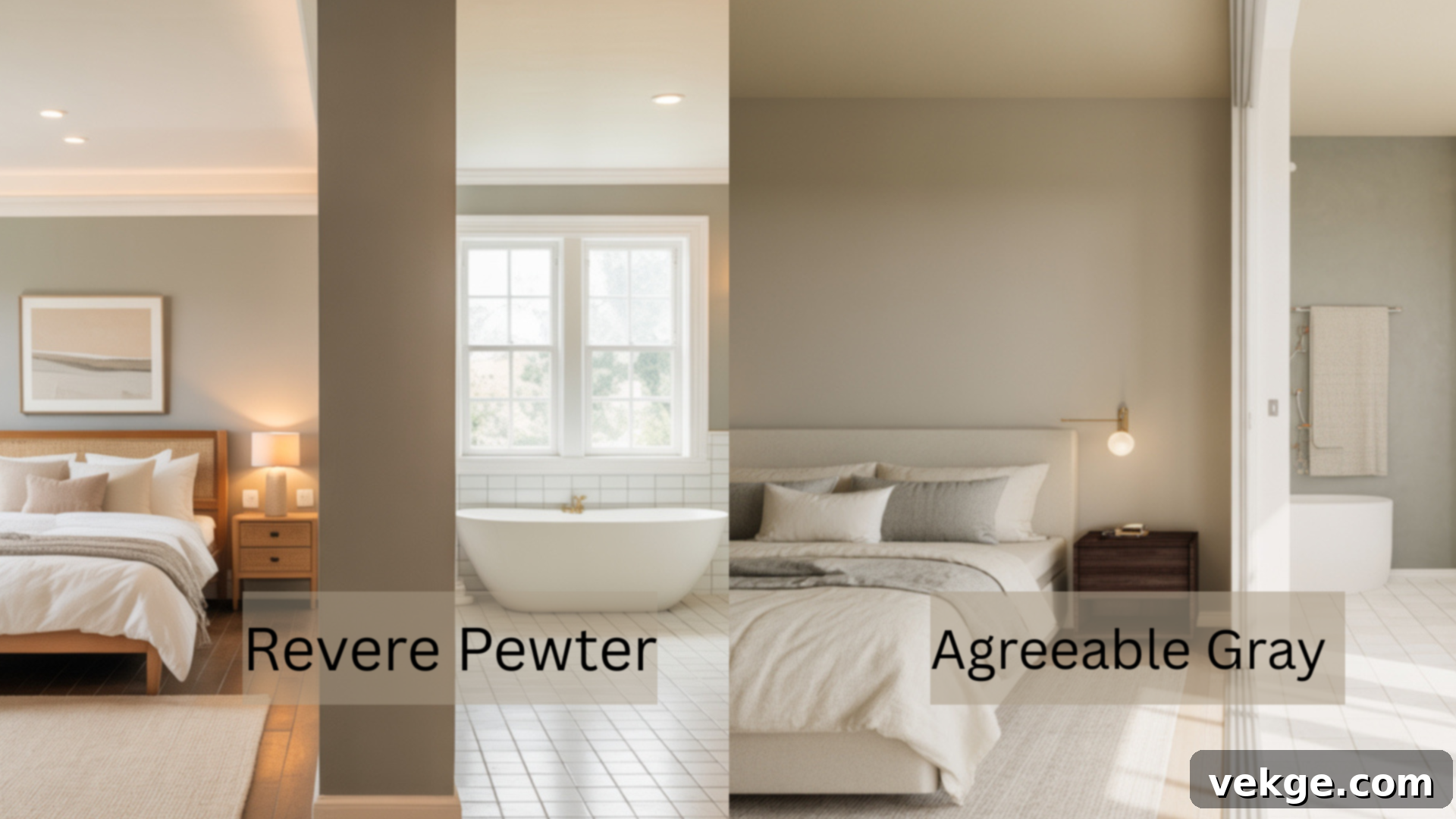
In private spaces like bedrooms and bathrooms, the soft, neutral tone of Agreeable Gray creates a wonderfully calm and restful atmosphere. Its adaptability means it supports nearly any decor style, from minimalist to bohemian. Crucially, its stability under artificial lighting—which is common in these rooms—makes it an ideal choice, as it won’t throw unexpected colors. It offers a fresh, clean feel in bathrooms, especially when paired with white fixtures and bright lighting.
Revere Pewter can offer a richer, more enveloping feel in bedrooms, making them feel incredibly cozy and luxurious. It pairs beautifully with warm wood furniture, plush textiles, and earthy bedding. However, in smaller bathrooms or those with limited natural light, Revere Pewter’s depth might make the space feel a little heavier or more enclosed. For larger bathrooms with ample natural light, it can create a spa-like retreat, but for most standard bathrooms, Agreeable Gray is generally the more forgiving and brightening option.
Exteriors & Outdoor Applications
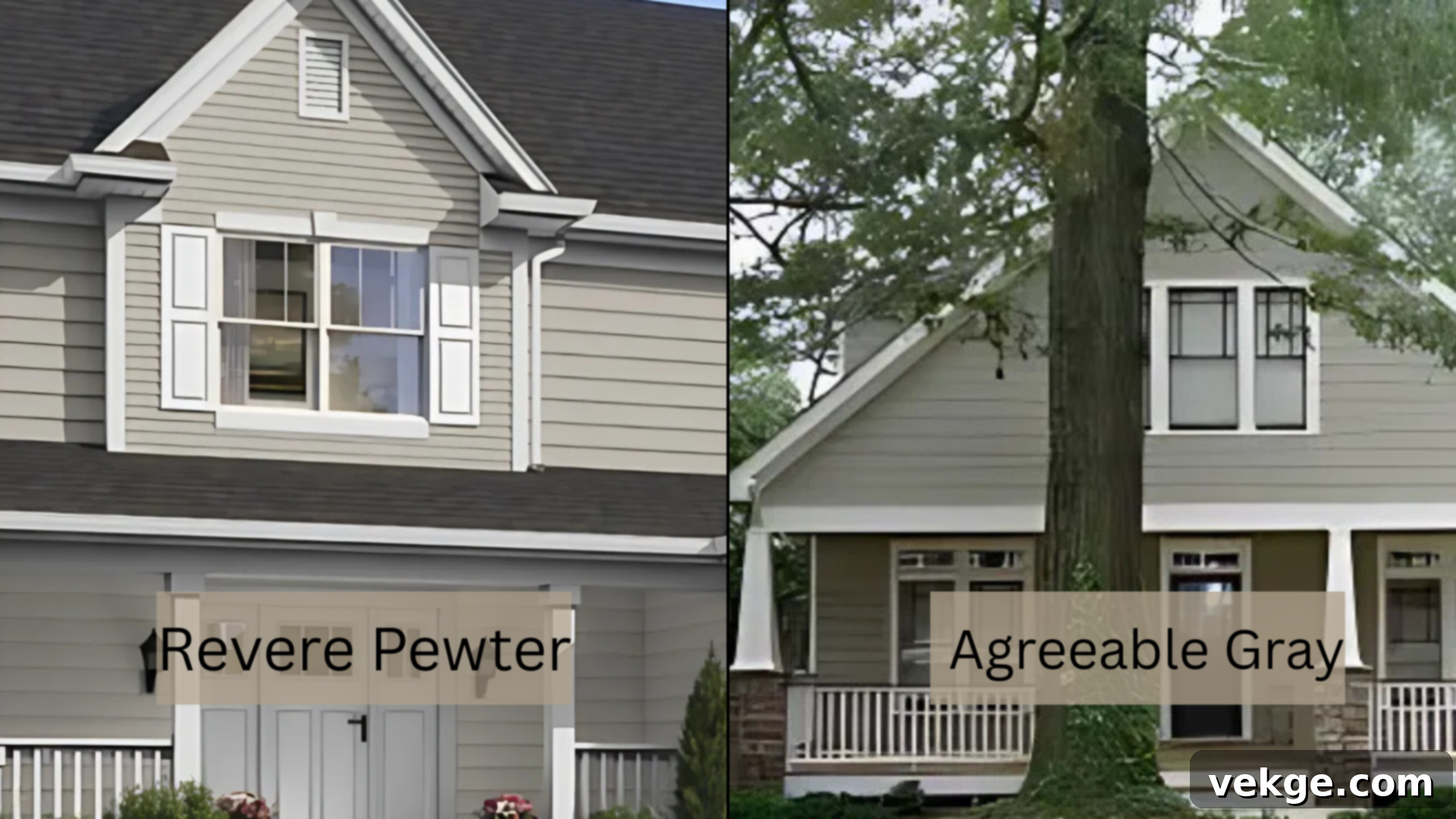
For home exteriors, Revere Pewter is a highly successful choice, particularly for siding, trim, or front doors. Its substantial depth ensures it holds its own against strong sunlight and beautifully complements natural elements like stone, brick, and lush landscaping. It bestows homes with a classic, welcoming, and elegant appearance, often appearing a bit brighter outside than it does indoors.
Agreeable Gray, being lighter, can sometimes appear a bit washed out in intense, direct sunlight on an entire facade. However, it excels as a choice for covered porches, exterior trim, or shaded outdoor areas where its softness can truly shine. For best results on exteriors, it is absolutely essential to test large swatches of both colors on different sides of your home. Observe them throughout the day to see how natural sunlight and shadow dramatically alter their appearance before committing to a full exterior paint job.
Matching Each Color to Your Home Style
The beauty of greige lies in its adaptability, but understanding how each shade aligns with specific interior design styles can guide you toward a more cohesive and confident choice.
Traditional & Classic Homes
If your home embraces a traditional or classic aesthetic, characterized by architectural details like crown molding, wainscoting, rich wood tones, and more ornate finishes, Revere Pewter is likely the perfect match. Its inherent warmth and depth provide a sophisticated and grounded backdrop that complements historical elements. It creates a timeless look that harmonizes beautifully with antique furniture, deep jewel tones, and classic patterns, leaning into its beige and soft green undertones to create an inviting, established feel.
While Agreeable Gray can still be incorporated into traditional settings, it tends to read as softer and might feel a bit too light or even somewhat modern unless carefully balanced. To make it work, you might introduce stronger contrasts, such as dark-stained wood trim, patterned Oriental rugs, or heavier, textured drapes to provide the visual weight often associated with traditional design.
Transitional & Modern Farmhouse
For homes that blend classic comfort with contemporary clean lines—styles like transitional, modern farmhouse, or even casual contemporary—Agreeable Gray truly shines. Its light, balanced, and neutral tone provides an airy foundation that beautifully complements popular elements such as black matte fixtures, crisp white shiplap, and various wood elements (from light oak to reclaimed barn wood). It helps to open up spaces, creating a fresh and uncluttered feel without appearing cold or stark.
Revere Pewter can also find its place within these styles, particularly on kitchen cabinetry, accent walls, or in more intimate areas like a study. It offers a subtle contrast and a touch of warmth that can break up an all-white or overly stark space, preventing it from feeling too sterile without venturing into overly bold or dark territory.
Coastal & Light-Filled Spaces
If your goal is a serene coastal vibe or you have a home flooded with abundant natural light, Agreeable Gray is undeniably the safer and often more effective choice. Its ability to maintain its airy, breezy quality in sun-drenched rooms makes it ideal for capturing that relaxed beach house aesthetic. Pair it with soft blues, sandy neutrals, pale driftwood tones, and crisp white linens to enhance the tranquil, expansive feel.
Revere Pewter may come off as too heavy or too earthy in exceptionally bright, coastal-inspired spaces, especially if its green undertones become prominent. However, it could still be used thoughtfully in shaded corners, on interior doors, or as a contrasting color for built-ins to introduce a subtle touch of depth without overwhelming the light and airy theme.
Revere Pewter vs. Agreeable Gray: Similar and Complementary Colors
Once you’ve zeroed in on your primary greige, selecting the right trim, accent colors, and wood tones is paramount to creating a cohesive and polished look. This section also explores close alternatives if you’re still exploring options.
Agreeable Gray (SW 7029): Closest Matches and Alternatives

If Agreeable Gray is almost perfect but you want to explore similar options, here are some close comparisons from various brands:
| Color Name | Brand | Hex Code | LRV | Notes |
|---|---|---|---|---|
| Agreeable Gray (SW 7029) | Sherwin-Williams | #D1CBC1 | 60 | Soft, balanced taupe-gray; exceptionally consistent in most lighting conditions. |
| Repose Gray (SW 7015) | Sherwin-Williams | #CCC8C1 | 58–59 | Slightly cooler and more neutral than Agreeable Gray, with subtle purple undertones sometimes visible. |
| Anew Gray (SW-7030) | Sherwin-Williams | #BFB6AA | 47 | A deeper and noticeably warmer gray with more pronounced brown/taupe undertones, offering more saturation. |
| Collingwood (OC-28) | Benjamin Moore | #D3CEC4 | 61.52 | A very close Benjamin Moore match, slightly lighter and equally soft, with subtle violet-gray undertones. |
| Silver Drop (7902-C) | Behr | #D8D6CE | ~69 | Significantly lighter and cleaner; a slightly cooler greige than Agreeable Gray, with more of a true gray feel. |
Revere Pewter (HC-172): Closest Matches and Alternatives
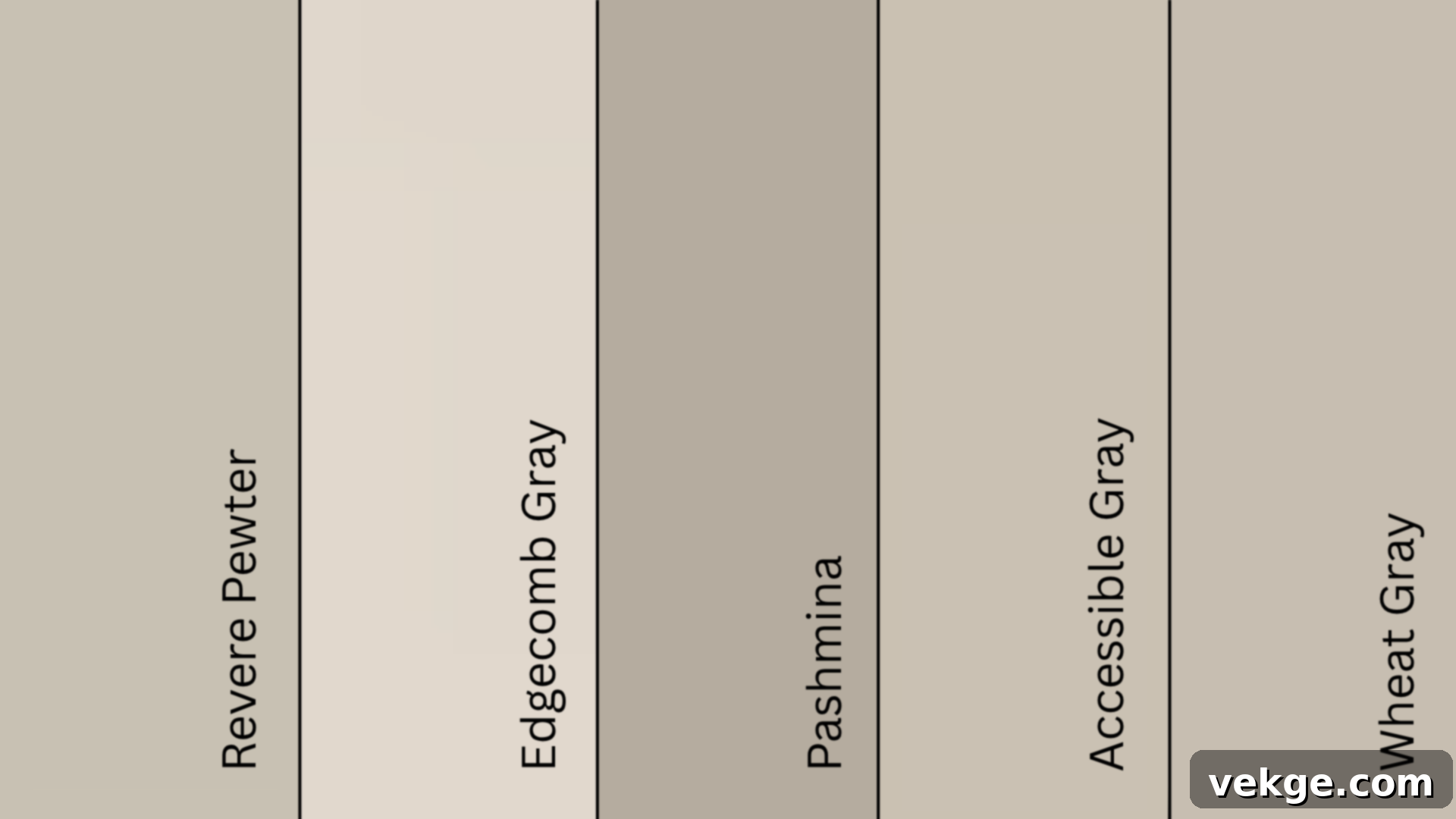
If Revere Pewter’s character appeals to you, but you’re exploring similar options, consider these close alternatives:
| Color Name (Code) | Brand | Hex Code | LRV | Notes |
|---|---|---|---|---|
| Revere Pewter (HC-172) | Benjamin Moore | #CBC6B8 | 55.98 | Warm beige with green undertones; a classic, versatile greige with notable depth. |
| Edgecomb Gray (HC-173) | Benjamin Moore | #DAD1C4 | 63.88 | Lighter and less earthy than Revere Pewter, with a softer, more off-white appearance and subtle taupe undertones. |
| Pashmina (AF-100) | Benjamin Moore | #BBB2A1 | 44.2 | A richer and deeper greige with a soft brown base, offering more saturation and a cozier feel than Revere Pewter. |
| Accessible Beige (SW 7036) | Sherwin-Williams | #D1C7B8 | 58 | A warmer beige-gray with more pronounced beige notes; often considered Sherwin-Williams’ closest match to Revere Pewter, without the green undertone. |
| Wheat Bread (720C-3) | Behr | #CDC4B7 | ~56 | Similar in depth and warmth to Revere Pewter, but with a slightly softer, less overtly green character. |
Best Pairings and Trim Suggestions for Revere Pewter and Agreeable Gray
Once you’ve made your primary color selection, the next step is to choose complementary elements that enhance your chosen greige. The right trim, accent colors, and wood tones are essential for a harmonious and polished space.
Whites That Work for Trim and Ceilings
The perfect white trim can dramatically elevate your chosen wall color. Here are some excellent white options that pair beautifully with both Revere Pewter and Agreeable Gray:
- Alabaster (SW 7008, #EDEAE0): A very popular soft, off-white that offers a gentle contrast without feeling stark. It brings a cozy warmth and pairs exceptionally well with both greiges, especially with Revere Pewter to emphasize its inherent warmth.
- Pure White (SW 7005, #EDECE6): This crisp but not blinding white provides a clean and fresh contrast. It works wonderfully to highlight the subtle tones of Agreeable Gray, making the room feel bright and contemporary. With Revere Pewter, it offers a more defined, classic trim.
- Shoji White (SW 7042, #E6DFD3): If you desire a softer, creamier white that seamlessly blends rather than starkly contrasts, Shoji White is an excellent choice. It’s perfect for creating a muted, organic feel, especially in spaces where you want a very subtle transition between walls and trim.
Always test your chosen white trim alongside your main wall color in your space, as even whites can reveal unexpected undertones under different lighting conditions.
Accent Colors to Try With Each Shade
Accent colors are key to adding personality and depth. For Revere Pewter, warm and earthy tones work best to draw out its rich, grounded character. Consider accents in:
- Terracotta or Burnt Orange: For an inviting, rustic warmth.
- Deep Sage or Olive Green: To complement its green undertones and enhance a natural, organic feel.
- Bronze, Copper, or Brushed Gold: Metallic accents that add sophistication and warmth.
- Dusty Rose or Muted Plum: For a softer, more romantic touch.
For Agreeable Gray, which is more adaptable, you can lean into cooler, calming shades or maintain a soft, ethereal palette:
- Navy, Charcoal, or Slate Blue: To provide a sophisticated contrast and ground the lightness of the walls.
- Soft Pastels (e.g., pale blush, mint green, light sky blue): For an airy, gentle, and modern aesthetic.
- Polished Chrome or Matte Black: For contemporary metallic accents.
- Muted Teal or Emerald Green: To add a subtle pop of color that feels fresh and sophisticated.
The goal is not to match perfectly but to create harmony through thoughtful contrasts or complementary tones. Think about throw pillows, artwork, ceramics, or even a statement piece of furniture.
Wood Finishes That Bring Balance
Both Revere Pewter and Agreeable Gray pair wonderfully with a wide spectrum of wood finishes, from light to dark, which can significantly influence the overall mood of a room:
- Lighter Woods (e.g., White Oak, Maple, Birch): These finishes contribute to an open, airy, and contemporary feel. They work particularly well with Agreeable Gray, enhancing its brightness, and can provide a fresh contrast to the depth of Revere Pewter.
- Medium Woods (e.g., Ash, Light Walnut, Cherry): Offering a classic and versatile warmth, medium-toned woods complement both greiges beautifully. They can add a timeless quality to a room painted with Agreeable Gray and deepen the established feel of a Revere Pewter space.
- Darker Woods (e.g., Walnut, Mahogany, Espresso): Dark woods create a sense of richness, elegance, and grounding. Revere Pewter, with its deeper base, truly shines alongside darker finishes, embracing a more traditional or formal aesthetic. Agreeable Gray can also work with dark woods, creating a striking contrast that feels very modern and intentional.
Before making a final decision, always place a wood sample (flooring, furniture, or cabinet door) next to your paint swatch. This visual test helps identify any potential clashes and ensures the combination achieves your desired balance of warmth, contrast, and style.
Long-Term Wear and Color Longevity of Greige Paints
Beyond initial aesthetics, consider how your chosen paint color will perform and hold up over time. Paint isn’t just a decorative element; it’s an investment in your home’s enduring beauty.
How Each Color Looks Over Time
Revere Pewter generally maintains its warm, cozy tone in areas with consistent or lower light levels. However, its dynamic nature means that in rooms bathed in bright natural light, especially from south or west-facing windows, its beige components can become more prominent, and its subtle green undertones may occasionally assert themselves, giving it a slightly different cast. This shifting character is part of its charm for some, but something to be aware of for others.
Agreeable Gray, by contrast, is celebrated for its remarkable consistency. It tends to hold its original, balanced greige tone across a wide range of lighting conditions and over many years. This makes it an incredibly reliable option if your priority is a paint color that will look the same from morning to evening, season to season, and remain true to its initial swatch appearance as your home evolves.
Resistance to Fading, Yellowing, and Dullness
Both Benjamin Moore and Sherwin-Williams produce high-quality paints designed for durability and color retention. When using premium formulations, both Revere Pewter and Agreeable Gray offer good resistance to typical paint degradation issues:
- Fading: Both colors, especially in their respective brand’s higher-quality lines (like Benjamin Moore Aura or Sherwin-Williams Emerald), are formulated with pigments that resist UV fading, even in sunny rooms. Agreeable Gray’s lighter, more balanced composition might appear to hold up marginally better in extremely high-sunlight exposure simply because there’s less pigment to visibly break down.
- Yellowing: Modern paint formulations, particularly water-based acrylics, are excellent at resisting yellowing over time, unlike older oil-based paints. Neither Revere Pewter nor Agreeable Gray should exhibit significant yellowing if a good quality, acrylic-based paint is used.
- Dullness: The perception of dullness often relates back to lighting. Revere Pewter might *appear* more muted or heavier in perpetually low-light spaces, which could be mistaken for dullness. Agreeable Gray’s higher LRV means it reflects more light, often maintaining a brighter, fresher appearance even in less-than-ideal lighting.
Ultimately, with proper surface preparation and the use of quality paint, both colors offer excellent longevity. However, if absolute color stability and minimal perception of shift are paramount, Agreeable Gray is generally the more forgiving choice, making it ideal for high-traffic areas and open layouts where color consistency is highly valued.
Final Thoughts and How to Make Your Decision
You now possess a deep understanding of the unique characteristics that differentiate Benjamin Moore Revere Pewter and Sherwin-Williams Agreeable Gray. From their subtle undertones and light reflectance values to their ideal applications in various rooms and home styles, you have the knowledge to make an informed decision for your space.
To recap:
- Choose Revere Pewter if you desire a deeper, richer greige with a distinct warm-beige and soft green undertone, lending itself to more traditional, grounded, and cozy aesthetics, particularly in spaces with ample light where its character can truly emerge.
- Opt for Agreeable Gray if you seek a lighter, more consistently balanced greige that reads as soft, airy, and adaptable in almost any lighting. It’s perfect for modern, transitional, and open-concept homes where consistency and brightness are key.
The most crucial step before committing to a gallon (or several!) is to test these colors in your own home. Purchase peel-and-stick samples or paint large swatches on different walls in the room you intend to paint. Observe them at various times throughout the day and under different lighting conditions—morning, noon, evening, and with both natural and artificial light. See how they interact with your furniture, flooring, and fixed elements like countertops or cabinetry. This real-world test is indispensable for confirming which shade truly resonates with your home’s unique environment and your personal style.
Remember, each of these renowned greige shades brings its own unique strength and personality. The “best” one is simply the one that feels most right, most beautiful, and most harmonious in your specific space. Embrace the process, trust your instincts, and enjoy creating a home that truly reflects you.
Still exploring your options or need more comparisons? Feel free to visit other color comparison posts on our website for additional side-by-side analyses and expert recommendations!
